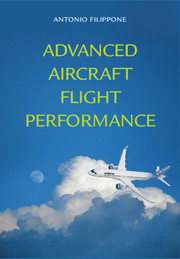Book contents
- Frontmatter
- Contents
- Tables
- Preface
- Nomenclature
- Technology Warning
- 1 Prolegomena
- 2 Aircraft Models
- 3 Weight and Balance Performance
- 4 Aerodynamic Performance
- 5 Engine Performance
- 6 Propeller Performance
- 7 Airplane Trim
- 8 Flight Envelopes
- 9 Take-Off and Field Performance
- 10 Climb Performance
- 11 Descent and Landing Performance
- 12 Cruise Performance
- 13 Manoeuvre Performance
- 14 Thermo-Structural Performance
- 15 Mission Analysis
- 16 Aircraft Noise: Noise Sources
- 17 Aircraft Noise: Propagation
- 18 Aircraft Noise: Flight Trajectories
- 19 Environmental Performance
- 20 Epilogue
- Appendix A Gulfstream G-550
- Appendix B Certified Aircraft Noise Data
- Appendix C Options for the FLIGHT Program
- Index
- References
3 - Weight and Balance Performance
Published online by Cambridge University Press: 05 January 2013
- Frontmatter
- Contents
- Tables
- Preface
- Nomenclature
- Technology Warning
- 1 Prolegomena
- 2 Aircraft Models
- 3 Weight and Balance Performance
- 4 Aerodynamic Performance
- 5 Engine Performance
- 6 Propeller Performance
- 7 Airplane Trim
- 8 Flight Envelopes
- 9 Take-Off and Field Performance
- 10 Climb Performance
- 11 Descent and Landing Performance
- 12 Cruise Performance
- 13 Manoeuvre Performance
- 14 Thermo-Structural Performance
- 15 Mission Analysis
- 16 Aircraft Noise: Noise Sources
- 17 Aircraft Noise: Propagation
- 18 Aircraft Noise: Flight Trajectories
- 19 Environmental Performance
- 20 Epilogue
- Appendix A Gulfstream G-550
- Appendix B Certified Aircraft Noise Data
- Appendix C Options for the FLIGHT Program
- Index
- References
Summary
Overview
The aircraft weight influences the performance of the airplane more than any other parameter. Weight has been of concern from the earliest days of aeronautics (§ 3.1). Therefore, we devote this chapter to the weight analysis and the relative aspects, such as operational and design weights (§ 3.2); weight management issues (§ 3.3); operational limits (§ 3.4); centre of gravity envelopes (§ 3.5); loading and certification issues, operational moments and corresponding errors (§ 3.6); the use of the wing tanks (§ 3.7); and, finally, mass properties, including determination of the CG and the moments of inertias of the empty airplane (§ 3.8).
KEY CONCEPTS: Aircraft Size, Design Weights, Operational Weights, Mass Distribution, Centre of Gravity Envelopes, Moments of Inertia, Fuel Tanks.
A Question of Size
By the start of the First World War, in the United Kingdom it was believed that the limiting weight of the airplane could not exceed 2,000 lb (∼800 kg). Aircraft engineers of that time ignored that in 1913–1914 the great Igor Sikorsky designed, built and flew a four-engine aircraft known as Ily'a Murometz, or S-27, whose loaded weight was 5,400 kg. The total installed power was about 400 hp (∼300 kW). The aircraft could carry as many as 16 passengers in its uncomfortable quarters.
Prior to this project, it was widely believed that a multi-engine aircraft would not be capable of flying. The main concern centred around the question of how to control the aircraft in the event of one engine failure – a likely occurrence in those days.
- Type
- Chapter
- Information
- Advanced Aircraft Flight Performance , pp. 45 - 77Publisher: Cambridge University PressPrint publication year: 2012



